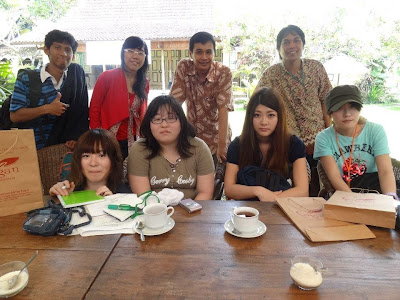I
think I will start with some of question words. When? Where? How? What? Why? No! That’s not Indonesian Language
lesson for making a good paragraph. Those are the questions that I really need
to be answered in my life. Well, I guess you will never know what’s going to
happen next.
Sometime, I feel like I’m the luckiest person alive, to be
given different and wonderful opportunities :)
When I was in 4th term, I don’t remember the
date exactly. I had a great chance to accompany professor and students from
Chubu University, Japan. They were doing some research about Indonesian
teenager in Yogyakarta. The research was mostly done within the Faculty of
Cultural Science Universitas Gadjah Mada (UGM). Just as I thought, they came
not only for the research but also to have fun in their spare time. Well, I was
a lucky second grader to have been assigned with my seniors, whose skill is far
beyond my reach, to accompany them. That time, one of my sensei asked me “Sansan,
could you accompany Aoki sensei and his students to have some tour around
Yogyakarta?” That was an unforgettable request. Of course because I didn’t want
to miss the chance, I answered “Yes, I can” with cheerful smile ((:
The first trip was to visit the Batik factory located at
Kaliurang. Just for information, on October 2, 2009, UNESCO designated
Indonesian Batik as a Masterpiece of Oral and Intangible Heritage of Humanity.
Only in the late 19th century that this art began to reach its
finest form in Java, Indonesia, my beloved country! Thus Indonesian Batik has become very popular
throughout the world.
At Kaliurang, Batik factory
That was one of the most exciting moments in my life, to
have the chance to learn about Batik. Batik is a complex art of drawing and
dyeing on fabric, and not as simple as your everyday printing. The word Batik
derived from Javanese words for ‘writing’ and ‘dots’, which is the art of
drawing beautiful patterns with canting and melting wax. The first step is
drawing a pattern on the fabric with pencil. By using canting and melting wax, we produce the color by re-draw the
pattern on the ones drawn earlier. The wax part on fabric will remain white.
That’s how to make one-colored Batik.
For two colored-three colored (or more) Batik, you need to dry the fabric and
cover all the part with the melting wax, except the part you want to dye. More
colors means you need to repeat the methods, and will take a lot of time to
make it. That is why handmade Batik worth the price because it’s made by
traditional Batik artist and totally different from a modern fabric-printing
with Batik motives.
My own made
The second day we went to Borobudur. It’s located at
Magelang, Central Java. Borobudur is the oldest Buddhist temple and one of the
7 wonders of the world. The view was so wonderful, that was my second time
visiting Borobudur since my high school trip. It remains wonderful despite the
incoming heat wave from the sun at the noon.
So sweet :3 With Professor Aiko Sumio
*The legend said that if you fine one particular Stupa with
sitting Buddha in it and you can reach Buddha’s crossed feet, any of your wish
will come true.*
After we got tired walking around Borobudur, and of course
after the photo session with various poses, we went to grab some grub. We went
to Jejamuran where all the food made from mushroom, start from tongseng, satay,
etc. The foods were really tasty and delightful. Maybe because I was too hungry
I forgot to take the picture of the foods. For the dinner we went to Pizza Hut. Yummy :9
Itadakimasu ! Kanpai ~
That’s my exciting days with the good Professor and his
friendly students. I learnt many things from Japanese language to Japanese
people characteristic. Next time I will tell you about my other experiences
with Japanese people. See you on next
post :))
日本人礼儀正しいと考えられています
(Japanese people are considered to be polite)














konnichiwa..
BalasHapussaya berkunjung :) kebetulan lg googling tentang aoki sensei. salam kenal.
dhenok
http://dhenokhastuti.wordpress.com/2013/09/21/sayonara-aoki-san/